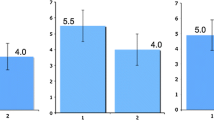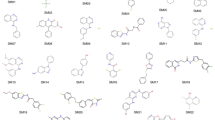Abstract
The distribution of errors is a central object in the assessment and benchmarking of computational chemistry methods. The popular and often blind use of the mean unsigned error as a benchmarking statistic leads to ignore distributions features that impact the reliability of the tested methods. We explore how the Gini coefficient offers a global representation of the errors distribution, but, except for extreme values, does not enable an unambiguous diagnostic. We propose to relieve the ambiguity by applying the Gini coefficient to mode-centered error distributions. This version can usefully complement benchmarking statistics and alert on error sets with potentially problematic shapes.







Similar content being viewed by others
Data availability statement
The data and codes that support the findings of this study are openly available at the following URL: https://doi.org/10.5281/zenodo.4333217
References
Pernot P, Civalleri B, Presti D, Savin A (2015) Prediction uncertainty of density functional approximations for properties of crystals with cubic symmetry. J Phys Chem A 119:5288–5304. https://doi.org/10.1021/jp509980w
Pernot P, Savin A (2018) Probabilistic performance estimators for computational chemistry methods: the empirical cumulative distribution function of absolute errors. J Chem Phys 148:241707. https://doi.org/10.1063/1.5016248
Pernot P, Savin A (2020) Probabilistic performance estimators for computational chemistry methods: systematic improvement probability and ranking probability matrix. I. Theory J Chem Phys 152:164108. https://doi.org/10.1063/5.0006202
Pernot P, Savin A (2020) Probabilistic performance estimators for computational chemistry methods: Systematic improvement probability and ranking probability matrix. II. Appl J Chem Phys 152:164109. https://doi.org/10.1063/5.0006204
Pernot P, Huang B, Savin A (2020) Impact of non-normal error distributions on the benchmarking and ranking of Quantum Machine Learning models. Mach Learn Sci Technol 1:035011. https://doi.org/10.1088/2632-2153/aba184
Bonato M (2011) Robust estimation of skewness and kurtosis in distributions with infinite higher moments. Finance Res Lett 8:77–87. https://doi.org/10.1016/j.frl.2010.12.001
Lorenz MO (1905) Methods of measuring the concentration of wealth. Publ Am Stat Assoc 9:209–219. https://doi.org/10.2307/2276207
Gini C (1912) Variabilità e mutabilità
Damgaard C, Weiner J (2000) Describing inequality in plant size or fecundity. Ecology 81:1139–1142. https://doi.org/10.2307/177185
Eliazar II, Sokolov IM (2010) Measuring statistical heterogeneity: the Pietra index. Phys A 389:117–125. https://doi.org/10.1016/j.physa.2009.08.006
Bendel RB, Higgins SS, Teberg JE, Pyke DA (1989) Comparison of skewness coefficient, coefficient of variation, and Gini coefficient as inequality measures within populations. Oecologia 78:394–400. https://doi.org/10.1007/BF00379115
Florian MK, Li N, Gladders MD (2016) The Gini coefficient as a morphological measurement of strongly lensed galaxies in the image plane. Astrophys J 832:168. https://doi.org/10.3847/0004-637X/832/2/168
Hurley N, Rickard S (2009) Comparing measures of sparsity. IEEE Trans Inf Theory 55:4723–4741. https://doi.org/10.1109/TIT.2009.2027527
Kleiber C (2005) The Lorenz curve in economics and econometrics. techreport, TU Dortmund, March. https://doi.org/10.17877/DE290R-14481
Dixon PM, Weiner J, Mitchell-Olds T, Woodley R (1987) Bootstrapping the Gini coefficient of inequality. Ecology 68:1548–1551. https://doi.org/10.2307/1939238
Ruppert D (1987) What is kurtosis? An influence function approach. Am Stat 41:1. https://doi.org/10.2307/2684309
Groeneveld RA, Meeden G (1984) Measuring skewness and kurtosis. Stat 33:391–399. http://www.jstor.org/stable/2987742, https://doi.org/10.2307/2987742
Suaray K (2015) On the asymptotic distribution of an alternative measure of kurtosis. Int J Adv Stat Proba 3:161–168. https://doi.org/10.14419/ijasp.v3i2.5007
Crow EL, Siddiqui MM (1967) Robust estimation of location. J Am Stat Assoc 62:353–389. https://doi.org/10.2307/2283968
Bickel DR (2002) Robust estimators of the mode and skewness of continuous data. Comput Stat Data Anal 39:153–163. https://doi.org/10.1016/S0167-9473(01)00057-3
Hedges SB, Shah P (2003) Comparison of mode estimation methods and application in molecular clock analysis. BMC Bioinform 4:31. https://doi.org/10.1186/1471-2105-4-31
Glasser GJ (1962) Variance formulas for the mean difference and coefficient of concentration. J Am Stat Assoc 57:648–654. https://doi.org/10.1080/01621459.1962.10500553
Zeileis A (2014) ineq: measuring inequality, concentration, and poverty. R package version 0.2-13. URL: https://CRAN.R-project.org/package=ineq
Harrell FE, Davis C (1982) A new distribution-free quantile estimator. Biometrika 69:635–640. https://doi.org/10.2307/2335999
Wilcox RR, Erceg-Hurn DM (2012) Comparing two dependent groups via quantiles. J Appl Stat 39:2655–2664. https://doi.org/10.1080/02664763.2012.724665
Efron B (1979) Bootstrap methods: another look at the jackknife. Ann Stat 7(1):1–26. https://doi.org/10.1214/aos/1176344552
R Core Team (2019) R: a language and environment for statistical computing. R Foundation for Statistical Computing, Vienna, Austria. URL: http://www.R-project.org/
Gentleman R, Carey V, Huber W, Hahne F (2019) genefilter: methods for filtering genes from high-throughput experiments. R package version 1(68)
Canty A, Ripley BD (2019) boot: bootstrap R (S-Plus) Functions. R package version 1.3-22
Evans M, Hastings N, Peacock B (2000) Statistical distributions. Wiley-Interscience, 3rd edition
Hoaglin DC (1985) Exploring data tables, trends, and shapes, chapter Summarizing shape numerically: the g-and-h distributions, pp 461–513. Wiley, New York
Borlido P, Aull T, Huran AW, Tran F, Marques MA, Botti S (2019) Large-scale benchmark of exchange-correlation functionals for the determination of electronic band gaps of solids. J Chem Theory Comput 15:5069–5079. https://doi.org/10.1021/acs.jctc.9b00322
Narayanan B, Redfern PC, Assary RS, Curtiss LA (2019) Accurate quantum chemical energies for 133000 organic molecules. Chem Sci 10:7449–7455. https://doi.org/10.1039/c9sc02834j
Schmidt PS, Thygesen KS (2018) Benchmark database of transition metal surface and adsorption energies from many-body perturbation theory. J Phys Chem C 122:4381–4390. https://doi.org/10.1021/acs.jpcc.7b12258
Thakkar AJ, Wu T (2015) How well do static electronic dipole polarizabilities from gas-phase experiments compare with density functional and MP2 computations? J Chem Phys 143:144302. https://doi.org/10.1063/1.4932594
Wu T, Kalugina YN, Thakkar AJ (2015) Choosing a density functional for static molecular polarizabilities. Chem Phys Lett 635:257–261. https://doi.org/10.1016/j.cplett.2015.07.003
Zaspel P, Huang B, Harbrecht H, von Lilienfeld OA (2019) Boosting quantum machine learning models with a multilevel combination technique: people diagrams revisited. J Chem Theory Comput 15(3):1546–1559. https://doi.org/10.1021/acs.jctc.8b00832
Zhang Y, Kitchaev DA, Yang J, Chen T, Dacek ST, Sarmiento-Perez RA, Marques MAL, Peng H, Ceder G, Perdew JP, Sun J (2018) Efficient first-principles prediction of solid stability: towards chemical accuracy. npj Comput Mater 4:9. https://doi.org/10.1038/s41524-018-0065-z
Nelder JA, Mead R (1965) A simplex method for function minimization. Comput J 7:308–313. https://doi.org/10.1093/comjnl/7.4.308
Kacker RN, Kessel R, Sommer K-D (2010) Assessing differences between results determined according to the guide to the expression of uncertainty in measurement. J Res Nat Inst Stand Technol 115(6):453. https://doi.org/10.6028/jres.115.031
Lejaeghere K, Jaeken J, Speybroeck VV, Cottenier S (2014) Ab initio based thermal property predictions at a low cost: an error analysis. Phys Rev B 89:014304. https://doi.org/10.1103/physrevb.89.014304
Lejaeghere K, Vanduyfhuys L, Verstraelen T, Speybroeck VV, Cottenier S (2016) Is the error on first-principles volume predictions absolute or relative? Comput Mater Sci 117:390–396. https://doi.org/10.1016/j.commatsci.2016.01.039
Proppe J, Husch T, Simm GN, Reiher M (2016) Uncertainty quantification for quantum chemical models of complex reaction networks. Faraday Discuss 195:497–520. https://doi.org/10.1039/c6fd00144k
Proppe J, Reiher M (2017) Reliable estimation of prediction uncertainty for physicochemical property models. J Chem Theory Comput 13:3297–3317. https://doi.org/10.1021/acs.jctc.7b00235
Author information
Authors and Affiliations
Corresponding author
Additional information
This work is dedicated to Ramon Carbó-Dorca for his 80th birthday. It reflects his interest for cross-disciplinary aspects of science, especially the role of mathematics in chemistry.
Publisher's Note
Springer Nature remains neutral with regard to jurisdictional claims in published maps and institutional affiliations.
Published as part of the special collection of articles “Festschrift in honour of Prof. Ramon Carbó-Dorca”.
Supplementary Information
Below is the link to the electronic supplementary material. Statistics, ECDFs and Lorenz curves for the literature datasets are also openly available at the following URL: https://doi.org/10.5281/zenodo.4333217
Rights and permissions
About this article
Cite this article
Pernot, P., Savin, A. Using the Gini coefficient to characterize the shape of computational chemistry error distributions. Theor Chem Acc 140, 24 (2021). https://doi.org/10.1007/s00214-021-02725-0
Received:
Accepted:
Published:
DOI: https://doi.org/10.1007/s00214-021-02725-0




